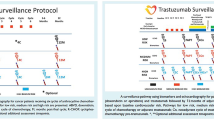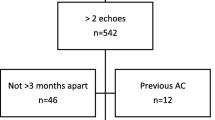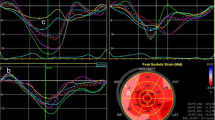Abstract
Background
Cardiotoxicity is a leading cause of morbidity and mortality among patients receiving cancer therapy. The most commonly used definition is cancer therapy-related cardiac dysfunction (CTRCD) defined by a left ventricular ejection fraction reduction. Global longitudinal strain (GLS) has been implied to be superior in detecting early subclinical dysfunction.
Objectives
Evaluate the prevalence of reduced GLS and whether it is associated with CTRCD development among patients receiving cancer therapy.
Methods
Data were collected as part of the Israel Cardio-Oncology Registry (ICOR), a prospective registry enrolling all adult patients receiving different types of cancer therapy, who were referred to the cardio-oncology clinic. Patients were divided into two groups—reduced GLS (> − 17%) vs. preserved GLS (≤ − 17%). Multivariable analyses were adjusted for a propensity score for baseline characteristics.
Results
Among 291 consecutive patients, 48 (16%) patients were included in the reduced GLS group. Overall, 11 (5%) patients developed CTRCD at following echocardiogram evaluation. Patients with preserved GLS had a significantly lower risk for CTRCD development [odds ratio (OR) 0.11, 95% confidence interval (CI) 0.03–0.41, p = 0.001], with every 1-unit improvement of GLS the risk of CTRCD decreased by 16% (OR 0.84, 95%CI 0.73–0.95, p = 0.007). After adjustment for baseline characteristics, including cardiovascular risk factors and systolic function, preserved GLS remained significantly associated with a lower risk for CTRCD development (OR 0.11, 95%CI 0.02–0.64, p = 0.014), with every 1-unit improvement lowering the risk by 19% (OR 0.81, 95%CI 0.67–0.98, p = 0.032).
Conclusions
Reduced GLS is common among patients receiving cancer therapy and may identify patients at increased risk for CTRCD development.
Graphic abstract


Similar content being viewed by others
Abbreviations
- CTRCD:
-
Cancer therapy-related cardiac dysfunction
- LVEF:
-
Left ventricular ejection fraction
- GLS:
-
Global longitudinal strain
- STE:
-
Speckle-tracking echocardiography
- ANT:
-
Anthracyclines
- LV:
-
Left ventricle
- SD:
-
Standard deviation
- IQR:
-
Interquartile ranges
- BB:
-
Beta blocker
- ACEI:
-
Angiotensin converting enzyme inhibitor
- ARB:
-
Angiotensin II receptor blocker
- LVEDD:
-
Left ventricle end diastolic diameter
- LVESD:
-
Left ventricle end systolic diameter
- OR:
-
Odd ratio
- CI:
-
Confidence interval
References
Siegel RL, Miller KD, Jemal A (2016) Cancer statistics, 2016. CA Cancer J Clin 66:7–30
Tilemann LM, Heckmann MB, Katus HA, Lehmann LH, Müller OJ (2018) Cardio-oncology: conflicting priorities of anticancer treatment and cardiovascular outcome. Clin Res Cardiol 107(4):271–280
Patnaik JL, Byers T, DiGuiseppi C, Dabelea D, Denberg TD (2011) Cardiovascular disease competes with breast cancer as the leading cause of death for older females diagnosed with breast cancer: a retrospective cohort study. Breast Cancer Res 13(3):R64
Zamorano JL, Lancellotti P, Muñoz DR, Aboyans V, Asteggiano R, Galderisi M et al (2016) ESC position paper on cancer treatments and cardiovascular toxicity developed under the auspices of the ESC Committee for Practice Guidelines. Eur Heart J 2016(37):2768–2801
Quiñones MA, Greenberg BH, Kopelen HA, Koilpillai C, Limacher MC, Shindler DM et al (2000) Echocardiographic predictors of clinical outcome in patients with left ventricular dysfunction enrolled in the SOLVD registry and trials: significance of left ventricular hypertrophy: studies of left ventricular dysfunction. J Am Coll Cardiol 35:1237–1244
Swain SM, Whaley FS, Ewer MS (2003) Congestive heart failure in patients treated with doxorubicin: a retrospective analysis of three trials. Cancer 91:2869–2879
Sawaya H, Seba IA, Plana JC, Januzzi JL, Ky B, Cohen V et al (2011) Early detection and prediction of cardiotoxicity in chemotherapy-treated patients. Am J Cardiol 107:1375–1380
Yoon HJ, Kim KH, Kim HY, Park H, Cho JY, Hong YJ, Park HW, Kim JH, Ahn Y, Jeong MH, Cho JG, Park JC (2019) Impacts of non-recovery of trastuzumab-induced cardiomyopathy on clinical outcomes in patients with breast cancer. Clin Res Cardiol 10:15. https://doi.org/10.1007/s00392-019-01417-x[Epub ahead of print] PMID: 30737527
Santoro C, Aripino G, Esposito R, Lembo M, Paciolla I, Cardalesi C et al (2017) 2D and 3D strain for detection of subclinical anthracycline cardiotoxicity in breast cancer patients: a balance with feasibility. Eur Heart J Cardiovasc Imaging 18:930–936
Cardinale D, Colombo A, Lamantia G, Colombo N, Civelli M, DeGiacomi G et al (2010) Anthracycline induced cardiomyopathy: clinical relevance and response to pharmacologic therapy. J Am Coll Cardiol 55:213–220
Wadhwa D, Fallah-Rad N, Grenier D, Krahn M, Fang T, Ahmadie R et al (2008) Trastuzumab mediated cardiotoxicity in the setting of adjuvant chemotherapy for breast cancer: a retrospective study. Breast Cancer Res Treat 117:357–364
Buckert D, Cieslik M, Tibi R, Radermacher M, Rasche V, Bernhardt P, Hombach V, Rottbauer W, Wöhrle J (2018) Longitudinal strain assessed by cardiac magnetic resonance correlates to hemodynamic findings in patients with severe aortic stenosis and predicts positive remodeling after transcatheter aortic valve replacement. Clin Res Cardiol 107(1):20–29
Sawaya H, Sebag IA, Plana JC, Januzzi JL, Ky B, Tan TC et al (2012) Assessment of echocardiography and biomarkers for the extended prediction of cardiotoxicity in patients treated with anthracyclines, taxanes, and trastuzumab. Circ Cardiovasc Imaging 5:596–603
Geyer H, Caracciolo G, Abe H, Wilansky S, Carerj S, Gentile F et al (2010) Assessment of myocardial mechanics using speckle tracking echocardiography: fundamentals and clinical applications. J Am Soc Echocardiogr 23:351–369
Stanton T, Learno R, Marwick TH (2009) Prediction of all-cause mortality from global longitudinal speckle strain comparison with ejection fraction and wall motion scoring. Circ Cardiovasc Imaging 2(5):356–364
Sawaya H, Sebag IA, Plana JC, Januzzi JC, Ky B, Tan TC et al (2012) Assessment of echocardiography and biomarkers for the extended prediction of cardiotoxicity in patients treated with anthracyclines, taxanes, and trastuzumab. Circ Cardiovasc Imaging 5:596–603
Negishi K, Negishi T, Hare JL, Haluksa BA, Plana JC, Marwick TH (2013) Independent and incremental value of deformation indices for prection of trastuzumab induced cardiotoxicity. J Am Soc Echocardiogr 26:493–498
Dalen J, Thorstensen A, Aase SA, Ingul CB, Topr H, Vatten LJ et al (2010) Segmental and global longitudinal strain and strain rate based on echocardiography of 1266 healthy individuals: the HUNT study in Norway. Eur J Echocardiogr 11(2):176–183
Plana JC, Galderisi M, Barac A et al (2014) Expert Consensus for Multimodality Imaging Evaluation of adult patients during and after cancer therapy: a report from the American Society of Echocardiography and the European Association of Cardiovascular Imaging. J Am Soc Echocardiogr 27(9):911–939
Lang RM, Badano LP, Mor-avi V, Afilalo J, Armstrong A, Ernande L et al (2015) Recommendations for cardiac chamber quantification by echocardiography and the European Association of Cardiovascular Imaging. J Am Soc Echocardiogr 28(1–39):E14
Charbonnel C, Convers-Domart R, Rigaudeau S (2017) Assessment of global longitudinal strain at low-dose anthracycline-based chemotherapy, for the prediction of subsequent cardiotoxicity. Eur Heart J Cardiovasc Imaging 18:392–401
Fujikura K, Peltzer B, Tiwari N, Shim HG, Dinhofer AB, Shitole SG et al (2018) Reduced global longitudinal strain is associated with increased risk of cardiovascular events or death after kidney transplant. Int J Cardiol 272:323–328
Krishnasamy R, Isbel NM, Hawley CM, Pascoe EM, Burrage M, Leano R et al (2015) Left ventricular global longitudinal strain (GLS) is a superior predictor of all-cause and cardiovascular mortality when compared to ejection fraction in advanced chronic kidney disease. PLoS One 10(5):e0127044
Laufer-Perl M, Derakhshesh M, Milwidsky A, Mor L, Ravid D, Amrami N et al (2016) Usefulness of global longitudinal strain for early identification of subclinical left ventricular dysfunction in patients with active cancer. Am J Cardiol 122(10):1784–1789
Negishi K, Negishi T, Haluska BA, Hare JL, Plana JC, Marwick TH (2014) Use of speckle strain to assess left ventricular response to cardiotoxic chemotherapy and cardioprotection. Eur Heart J Cardiovasc Imaging 15(3):324–331
Gulati G, Heck SL, Ree AH, Hoffmann P, Schulz-Menger J, Fagerland MW et al (2016) Prevention of cardiac dysfunction during adjuvant breast cancer therapy (PRADA): a 2 × 2 factorial, randomized, placebo-controlled, double-blind clinical trial of candesartan and metoprolol. Eur Heart J 37(21):1671–1680
Bosch X, Rovira M, Sitges M, Domènech A, Ortiz-Pérez JT, de Caralt TM et al (2013) Enalapril and carvedilol for preventing chemotherapy-induced left ventricular systolic dysfunction in patients with malignant hemopathies: the OVERCOME trial (prevention of left ventricular dysfunction with enalapril and carvedilol in patients submitted to intensive chemotherapy for the treatment of malignant hemopathies). J Am Coll Cardiol 61(23):2355–2362
Thavendiranathan P, Poulin F, Lim KD, Plana JC, Woo A, Marwick TH (2014) Use of myocardial strain imaging for the early detection of cardiotoxic patients during and after cancer chemotherapy: a systematic review. J Am Coll Cardiol 63(25 Pt A):2751–2768
El-Sherbeny WS, Sabry NM, Sharbay RM (2019) Prediction of trastuzumab-induced cardiotoxicity in breast cancer patients receiving anthracycline-based chemotherapy. J Echocardiogr 17(2):76–83
Rhea IB, Uppuluri S, Sawada S, Schneider BP, Feigenbaum H (2015) Incremental prognostic value of echocardiographic strain and its association with mortality in cancer patients. J Am Soc Echocardiogr 28(6):667–673
Bower JE, Ganz PA, Irwin MR, Castellon S, Arevalo J, Cole SW (2013) Cytokine genetic variations and fatigue among patients with breast cancer. J Clin Oncol 31(13):1656–1661
Funding
None.
Author information
Authors and Affiliations
Corresponding author
Ethics declarations
Conflict of interest
The authors have no conflicts of interest.
Rights and permissions
About this article
Cite this article
Laufer-Perl, M., Arnold, J.H., Mor, L. et al. The association of reduced global longitudinal strain with cancer therapy-related cardiac dysfunction among patients receiving cancer therapy. Clin Res Cardiol 109, 255–262 (2020). https://doi.org/10.1007/s00392-019-01508-9
Received:
Accepted:
Published:
Issue Date:
DOI: https://doi.org/10.1007/s00392-019-01508-9




